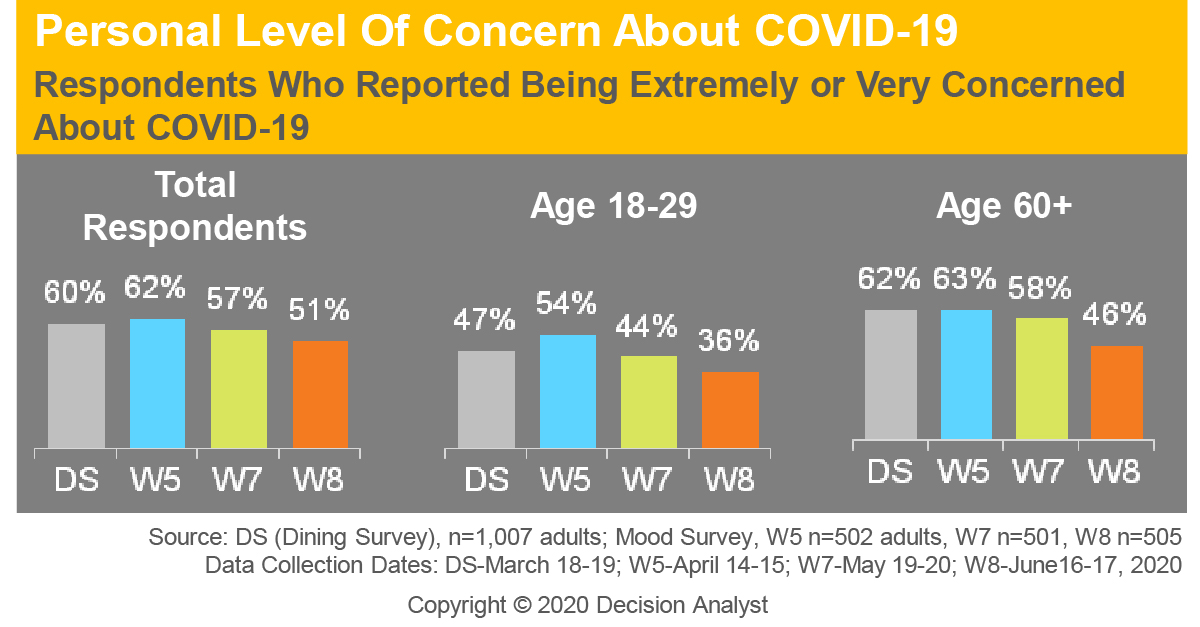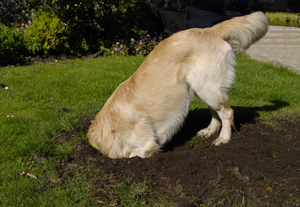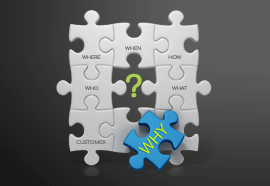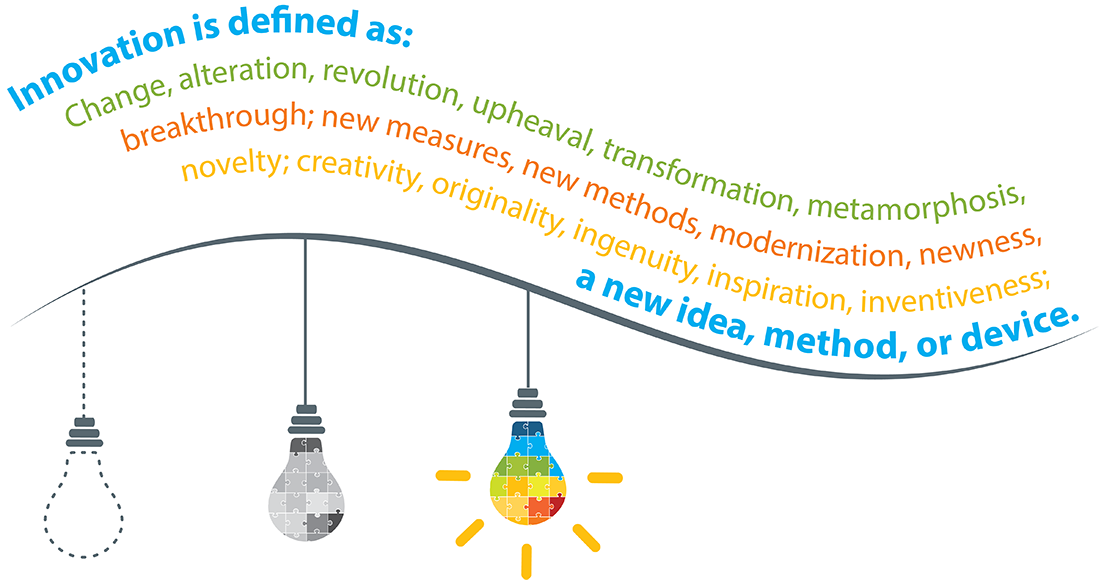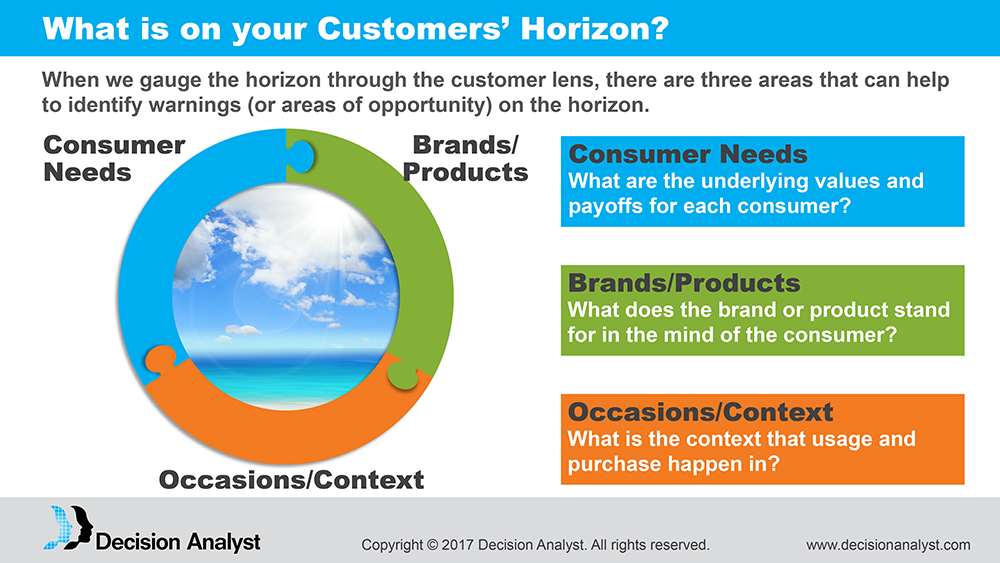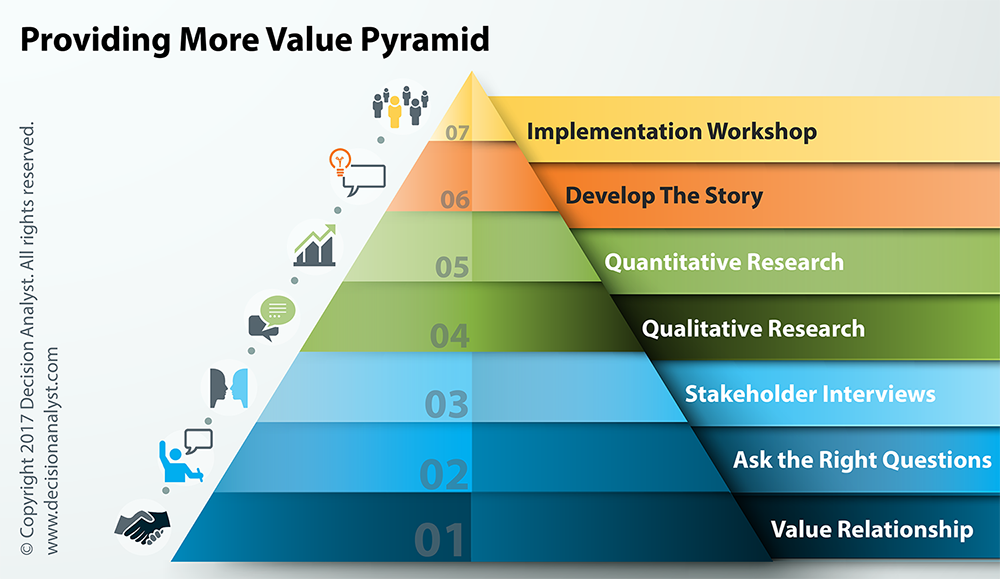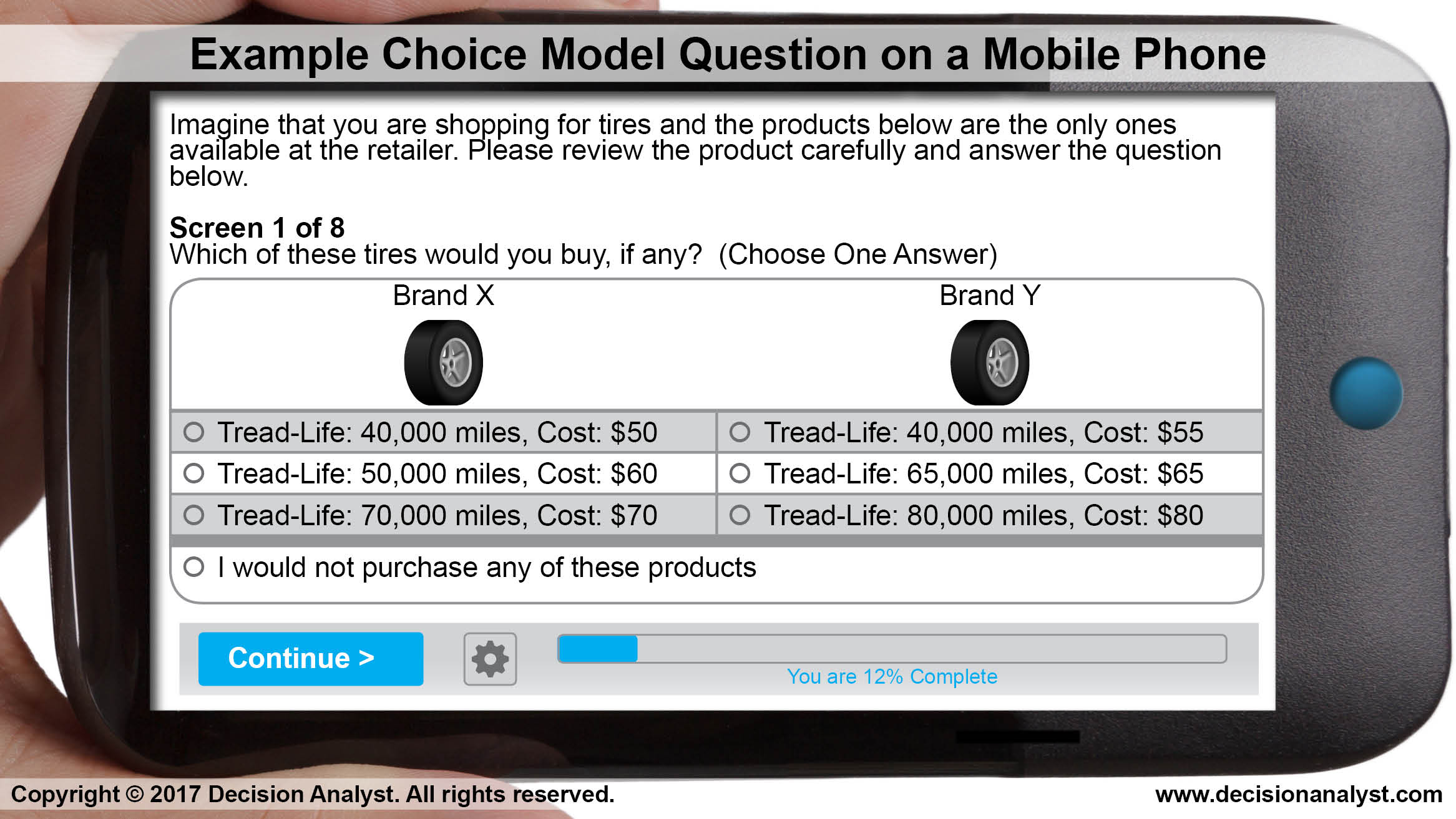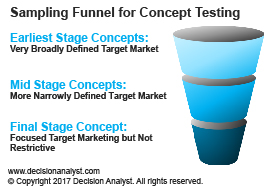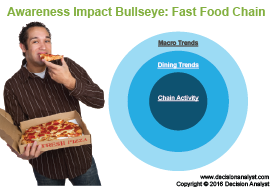Blog Archives
2021 Blogs
-
1Dec
Getting Comfortable: An Unexpected Theme During The Pandemic by Felicia Rogers
It’s no secret that when COVID-19 hit the U.S., life changed swiftly and dramatically. Most people began spending so much time in their homes that desires to spruce things up emerged almost immediately.
What exactly were homeowners doing? Here’s a summary of activities from our ongoing Consumer Reactions to COVID-19 research.
more -
18Oct
Reliability and Validity from a Scientific Perspective by Elizabeth Horn, Ph.D.
Different words can be synonymous in a casual conversation, but take on different meanings in a scientific context. Both “reliable” and “valid,” for instance, are used to mean “robust” or “accurate” in everyday speech.
The concepts of reliability and validity are not interchangeable from a scientific perspective, however. These two words are not identical, and understanding the difference is important when interpreting research outcomes.
more -
28Sep
How to Succeed in a World Gone Supply Chain and Logistics Crazy! by Bonnie Janzen
How can your organization manage the craziness in this world, given all the supply chain and logistics challenges? So how is a business supposed to succeed in the midst of all this chaos?
Given all of these outside “unusual demands and supply chain constraints” on business, over-delivering on the customer experience can really pay off. Here are a few ideas to help you surprise and delight your customers during these times.
more -
3Sep
The 411 About Deriving Marketing Claims From Market Research by Sara Sutton and Sheela Avila
Have you heard that the average person has the attention span of a goldfish?
While that’s an exaggeration, it’s true that marketers have just a few seconds to capture a person’s interest in buying or recommending your product. To do this, companies will often use marketing claims, which are typically short, snappy phrases that pack a punch! Including impactful claims, using words and phrases that resonate with consumers, is an easy way to increase your product’s stopping power and ultimately increase sales.
more -
16Aug
5 Reasons To Think Like A Squirrel by Tom Allen
This is an article about how to think like a squirrel. The inspiration of thinking like a squirrel came from witnessing their behavior, oddly enough.
How should you think like a squirrel? Don’t take the shortest path to your destination. Look for new ways to accomplish your personal or business goals that might lead you to new experiences, relationships, sights, or locations.
more -
10Aug
Like its in-person counterpart, an online focus group allows businesses to use a moderator to talk directly to consumers to ask key questions, to show a variety of stimulus types, to capture group interaction, and more.
But, in conducting online qualitative, don’t forget the role of, and the importance of being a backroom observer. Here are four ways to use the backroom as a means to get the most from your qualitative research.
more -
21Jul
The New Kid In Town: Gen Z by Cari Peek
Social, economic, political, and technological advancements made a mark on Gen Z.
Understanding their generational mindset is vital to helping marketers better understand how to reach and communicate with consumers. Currently, Gen Z represents $44 billion in direct buying power in the U.S. – and most don’t even have jobs yet. As you read the details that follow, I challenge you to think about your brand and how Gen Z’s perspective on these events and societal norms may impact it.
more -
13Jul
Advertising Claims Substantiation by Jerry W. Thomas
Is it a good idea to make a head-to-head comparative claim against a competitor?
Before you rush off to create that great head-to-head commercial, a recommended best practice is to test a number of different advertising claims or messages, to see which types of claims resonate with your target audience. Here are some tips an advice for advertising claims substantiation.
more -
6Jul
Political Divide Deepens Around the Pandemic by Audrey Guinn, Ph.D.
Republicans, Democrats, and Independents seem to be drifting further apart and these differences are noticeable not only within political ideology but also within more mundane aspects of life.
Decision Analyst’s monthly “Consumer Reactions to COVID-19” tracker finds that these divisions exist within beliefs about COVID-19 and the vaccine, feelings surrounding the pandemic, concern about the pandemic, and even comfort levels with gathering in different situations.
more -
29Jun
Insights, Not Oversights! (A Market Research Checklist) by Sara Sutton and Stephanie Trevino
As market researchers, our goals and responsibilities are to deliver thoughtful, accurate, data-driven insights to our partners.
To do this successfully, we should always ask ourselves these questions: Is this methodology right for the audience, topic, and objectives? Am I being too narrow or making assumptions about my target population? Am I screening and including a representative set of respondents?
more -
21Jun
The Bridging Model: Connecting A Segmentation To Customer Databases by Elizabeth Horn, Ph.D.
Segmentation is a very powerful tool. When possible, leverage that power by applying the segmentation to your company’s customer database(s).
Organizations that successfully classify their customers into segments increase the likelihood that their brand communications and new products will meet the needs of those customers. This makes the time, effort, and investment to build the “bridge” worthwhile.
more -
11Jun
Who’s More Likely to Receive the COVID-19 Vaccine? by Audrey Guinn, Ph.D.
Personal characteristics and situational circumstances are potential explanations for why some people receive the vaccine while others do not.
Therefore, we wanted to understand differences in ethnicity, age, political affiliation, income, gender, area lived in, and occupation with regards to vaccination. To examine these potential demographic differences, we analyzed the data from Decision Analyst’s monthly “Consumer Reactions to COVID-19” tracker.
more -
1Jun
Consumer feedback. There’s the good, the bad, and the ugly.
When you’re seeking feedback through a survey, the good news is that you’re in control. A well-designed survey can help you answer the “whys” behind negative feedback and even help you understand which low-rated areas to prioritize. Here are three simple but effective ways to get the most out of survey feedback of all kinds.
more -
25May
Motivators for and Barriers to Getting Vaccinated Against COVID-19 by Audrey Guinn, Ph.D.
As of May 20th, 48% of the population has had at least one dose. However, that leaves a little over 50% of the population unvaccinated.
Using the data collected in Decision Analyst’s monthly “Consumer Reactions to COVID-19” tracker, we did examine what impact, if any, beliefs about COVID-19 and its vaccine have on the decision to get vaccinated.
more -
27Apr
Delivering bad news is an unpleasant task, but learning to do it effectively (and tactfully) can prevent a costly disaster in the marketplace.
It can also provide you an opportunity to boost your credibility and improve your professional relationship with the client. So, how do you tactfully relay bad news? Here are six tips to ensure your results are not just heard but accepted and acted upon.
more -
20Apr
Navigating Business-to-Business-to-Consumer Relationships by Julie Trujillo
What if you are one of the many companies whose product or service goes through an intermediary?
And, what if that intermediary has a strong influence on your brand’s relationship with the end customers? Operating in a business-to-business-to-consumer environment creates extra complexity to consider.
more -
13Apr
Like many of you, I spend a good part of my day thinking about all the ways the near future will (hopefully) be different from the past year.
But what will the future look like? I’m no futurist, but I see a short-term demand boom coming for many industries. This list is not all-inclusive but just a few examples.
more -
4Apr
Sins of the Fathers by Jerry W. Thomas
The Fathers of Marketing Research invented a number of extremely powerful and valuable tools, methods, questions, and concepts that we all use and benefit from every single day.
But no one is perfect, and our industry Fathers committed sins that blight our industry to this day.
more -
23Mar
5 Steps To Optimizing The Lifetime Value Of Customers by Sara Sutton
Customer loyalty directly improves the bottom line by increasing the lifetime value of each customer.
This is true in any industry, but particularly in those where the customer will interact with the brand (and its agents) over and over, such as in healthcare, insurance, financial services, travel, etc. Think about the following steps when optimizing the customer experience (and thus, the lifetime value of your customers).
more -
10Mar
In Search of the Holy Grail Customer Experience by Heather Kluter
Understanding the experience consumers have with brands is more important than ever, especially when attempting to get them to return to an abandoned brand and stick with it.
Traditionally, brands that win have always placed customer experience before everything else, but now understanding the changing, lasting expectations of post-pandemic consumers is more important than ever.
more -
2Feb
User-Centric Innovation: 3 Important Tactics To Help Ensure New Product Success by Felicia Rogers and Hillary Semmelman
Focusing on the consumer is a critical step to ensure new products meet the needs and expectations of end-users.
From a research perspective, there are several ways to engage with potential customers to help guide the innovation process. We’ll address three broad research tactics that many companies use to accomplish their goals: Qualitative Research, Concept Testing, and Choice Modeling.
more -
19Jan
It’s Time to Put Those Negatively Worded Items Behind Us by Audrey Guinn Ph.D.
In an effort to catch survey cheaters, researchers use negatively worded attributes placed in groupings of positively worded attributes.
This context switching causes respondent confusion, which creates error. It may be time for researchers to relinquish negatively worded attributes. So, how can researchers catch cheaters, speeders, and straight-liners if negatively worded attributes are no longer included in the survey?
more -
13Jan
2020 and its challenges have been extremely difficult to navigate!
Despite the long list of negatives from 2020, there are several positive trends from the year, including: Strengthening relationships, Connecting with loved ones, Improving communication between teachers and students, Focusing on self-care and mental health, Continuing work-from-home/work remotely, etc.
more
2020 Blogs
-
11Dec
Newton’s law of inertia: this law basically states that an object at rest will stay that way and that an object in motion will continue with the same speed and in the same direction unless that object is acted upon by an unbalanced force.
The COVID-19 pandemic has been an unbalanced force that has acted on two objects: consumers and organizations.
more -
30Nov
“I Know You’re Out There” Engaging Hard-To-Reach Tradespeople And Heavy Industry Pros by Patrick McGill (Managing Directory of Strategy at Two Rivers Marketing) and Mike Humphrey (Senior Vice President at Decision Analyst)
From consumer goods and services providers to business products and services, the audience for a primary research study is more often unique than not.
So, what can we do to best reach these hard-to-find but vital segments? While there’s sometimes a magic panel (where caution is advised) or other freely available list to turn to, there are some best practices and techniques available to increase our odds in the event that’s not the case.
more -
12Nov
Optimizing Parts Of A Whole by Elizabeth Horn
Commentary on choice modeling is confined mostly to discussions of optimizing an entire product or service, its pricing, and perhaps even its inclusion in the broader portfolio.
So what do we do with those products that are not wholes, but rather some individual component or ingredient? Often manufacturers want to optimize the features and the pricing for their product parts.
more -
28Oct
We’re Not Just A Vendor, But A True Partner (Blah, Blah, Blah) by Felicia Rogers
As the business world moves faster and faster and demands grow by the day, trusted advisors are needed more than ever.
From my vantage point I see researchers and strategists in corporate positions who are genuinely seeking support and advice from their peers and, more importantly, from those of us in agency-side roles. So, specifically, what should this “partnership” look like?
more -
20Oct
Fraud in Online Surveys by Justin W. Thomas
The incidence of fraud in online surveys is a growing problem. Fraud rates can be as high as 15% to 25% in some sources of online samples.
The research industry must minimize respondent fraud to protect the integrity of its survey results and safeguard the public’s trust in survey research findings. This blog explores some common types of fraud and outlines some approaches to minimizing fraud.
more -
6Oct
Brand-Loyalty Roadmap: It Works for Business and Nonprofits Alike by Lesley Johnson
I love the moisturizer I use. There are benefits and attributes I value about it. Each is an important piece of my decision to buy this product, and if any of these attributes changed, I would have to re-evaluate the product.
Both companies and nonprofits derive loyalty by providing benefits beyond just a product or social program. These benefits can be the way a product or organization makes consumers feel, the solution to a problem it champions, the attributes associated with it, or even the cachet of the brand or social cause itself.
more -
30Sep
The Joy of Innovation by Bonnie Janzen
Remember the joy of discovery?
You are the ‘voice of the customer’ in the organization, you are the starting point for innovation. You will be able to discover the consumer pain points, barriers to trial and usage and purchase journey, which will allow you to help your team and organization move customers beyond those pain points and barriers. You will be able to solve real-life problems for your customers, your employees, and any other stakeholder group that your business serves.
more -
18Sep
Decision Analyst’s Imaginators®: An Insiders View of the Online Ideation Process by Gretchen Riskind
I’ve been a qualitative researcher at Decision Analyst for a year now, and when in meetings with our clients or when designing research proposals I often hear my colleagues talk about using Decision Analyst’s Imaginators®.
As an experienced ideation leader, I’ve been waiting “patiently” for my opportunity to try it out. A few weeks ago, I finally got my chance when I was asked to lead an Imaginators® session for an internal project.
more -
31Aug
Three Secrets to Product Success by Tom Allen
There are many factors that go into a successful product: efficacy, price, value, brand, distribution, advertising, competitive forces, etc.
But when push comes to shove at the retail shelf, packaging can make or break a product. Brands need to ensure they are getting the most impact out of their packaging that they possibly can. How do they do that? With consumer research, of course!
more -
21Jul
Let’s Outlaw Marketing Research by Jerry W. Thomas
For almost 100 years, some large corporations have used marketing research to gain an unfair advantage over their competitors.
This is not fair, and does not lead to a fair marketplace. These “marketing research savvy” companies benefit from an “intelligence” or “informational” advantage over their competitors. The whole concept of free enterprise and free markets rests upon an assumption of fair and equal competition in a marketplace, and marketing research undermines this core principle.
more -
14Jul
Enhancing the Customer Experience With Usability Research by Roger Wallace
Usability testing plays an important role in creating a positive customer experience, and the principles applied in this type of research can also be a key part of the development process for many things beyond websites and apps.
The importance of using these principles and testing will only increase for marketers and innovators as our fast-paced world accelerates and demands for significant changes in how people interact with each other and their .
more -
1Jul
Consumer Driven Innovation by Heather Kluter
Heather Kluter, Senior Vice President, discusses how setting up a Consumer Driven Innovation process can fuel a new product development pipeline.
She discusses using Innovative consumers, trend tracking, exploring channels of influence and looking outside your industry for ideas can help feed your new product pipeline with consumer-centric ideas and concepts.
View Transcript -
26Jun
Consumer Reactions to Covid-19 by Decision Analyst
Nearly 9 in 10 Americans now tell us their area is beginning to relax shelter-in-place orders.
Concern about COVID-19 seems to be waning somewhat, though differences are noted across age groups.
more -
19Jun
Win-Loss Analysis: Understanding Customer Needs by Laura Latshaw
In B2B research, one of the biggest concerns is maintaining and growing business.
Win-Loss research is an excellent way to learn about how well your company does in developing and winning over new customers as well as assessing why customers choose to make a change and go to one of your competitors.
more -
11Jun
The big question, as we all begin moving forward again, seems to be, “How do we jump-start our business?”
What questions should we be asking? What actions should we be taking? What can we really expect from our customers, shoppers, or consumers? The truth is there’s no easy answer to these questions and no one really knows what the future will look like. But the good news is there are steps we can all take toward answering these big questions.
more -
4Jun
As stressful as this environment is, it could be an opportunity to evaluate where your company or nonprofit has been and where it wants to go.
Has what you’ve been doing up until now served you well? Is it time to adjust plans, change directions entirely, or double down on your current strategy? Do you have data that can help you answer strategic questions?
more -
14May
7 Steps Out of the Unknown: Product & Branding Strategy by Bonnie Janzen
There was so much promise and excitement at the start of the year and the decade, but now COVID-19 and its economic fallout has had tragic consequences for many companies and industries.
Now we must pick ourselves up and find our way through what might be the biggest challenge an organization or industry has ever faced. These 7 steps will help you focus on reimaging your brand by focusing on your product roadmap and reviewing your brand positioning.
more -
12May
The Business World Post-COVID-19 by Heather Kluter
In this tumultuous time many businesses are seeing their teams pulling together and connecting in ways they never have before.
This sense of being “all in this together” is allowing employees to be more of their authentic selves at work. They are now free to admit and share that they are juggling a lot – kids, pets, friends, partners, and general stress. With newfound empathy for each other, companies are reporting a heightened level of team collaboration that has not been seen before COVID-19.
more -
28Apr
Where’s My Herd? Connecting with Consumers in a Post-COVID World by Clay Dethloff
Regardless of the “when,” watercooler (or more correctly, Zoom) conversations are turning to what the normal will be like in the future.
A key part of our life that may be changed in the future is what a consumer group is, and their associations with “groups.” People by nature seek to belong to groups, and a general sense of community is important and needed, but what will it look like in the future?
more -
15Apr
Who’s taking my survey? by Julie Trujillo
Panel and sample quality is something all market researchers should be concerned about.
So, with that in mind, I thought perhaps it was time to take a step back and consider what we are doing to make sure we can answer the question, “Who’s taking my survey?”
more -
7Apr
The New World After COVID-19 by Jerry W. Thomas
Consumer attitudes and perceptions will be changed forever.
Industries, companies, and brands will be forced back to the drawing board to re-learn and re-understand their markets and their customers. Companies will have to reinvent, re-position, and rejuvenate their products, services, marketing, and advertising.
more -
17Mar
Is That New Product a Cannibal? by Elizabeth Horn, Ph.D.
Companies that expect to survive must introduce new or improved products regularly.
The reasons for this are numerous. With these pressures from purchasers, competition, and distribution channels, companies are faced with the task of rapidly introducing new products, sometimes at the expense of current ones.
more -
10Feb
Tail Up, Paws diggin’: Escaping the Silo Work Style by Heather Kluter
At the start of my career, I worked with the a top home builder. I joined the marketing and product development teams. When I had been there for about a year, an executive from a CPG manufacturer joined the company and brought much needed knowledge. He commented on our work style – like dogs, we were butts up, diggin’.
Cross-functional collaboration aren’t just nice to have. They are critical to success in today’s environment. Here’s why traditional, hierarchical org structures don’t work.
more -
10Feb
3 Avoidable Statistical Mistakes by Audrey Guinn, PH.D.
Marketing research is grounded in the scientific method: answering questions by generating a priori hypotheses, collecting data to test hypotheses, and analyzing data to draw conclusions. Adhering to the rules of the scientific method is important to ensure that results are valid and unbiased.
Sometimes marketing researchers are tempted to use undesirable methods, like conducting many single significance tests, performing statistical tests without hypotheses, and rerunning statistical tests until desired results are discovered. Unfortunately, engaging in these methods has unintended, detrimental consequences: namely, an increase in Type I Error.
more -
4Feb
No matter the product or service type, the most successful innovations are grounded in a consumer need or white space.
Rarely does an innovative and successful idea just appear in someone’s dreams or imagination. It’s typically more of a process of trial and error that can take years to conceptualize, prototype, test, and refine. Many innovations require rigorous scientific experimentation. Often engineering and industrial-design functions are also involved.
more -
30Jan
Eight Ways to Kick-Start the Decade! by Bonnie Janzen
As you start the New Year, you are not only saying hello to the beginning of a new year, but to a whole new decade!
As you think about your career and your business, how can you have more of a positive impact on your business or career? Much as you approached your personal goals and resolutions for 2020, consider starting a list of your business goals and resolutions.
more -
7Jan
Developing Innovative Ideas: What a Pain! by Michelle Dodd
Companies must continuously innovate in order to stay relevant and fresh.
This innovation may take the form of a new product, a revised product, new marketing channels, an expanded distribution strategy, a new ad campaign, etc. We frequently look to unmet needs for inspiration, but an often-overlooked source for innovative ideas can come from addressing pain points. Pain points typically impact an entire category, not just one brand. They are a ‘cost of doing business’ with this type of company.
more
2019
-
19Nov
Diving Deeper Into Diversity—Hispanic Research by José Marrero (President of JAM Consulting) and Mike Humphrey (Senior Vice President at Decision Analyst)
At a conference last year, a speaker asked the audience ‘what is the biggest challenge we face in marketing research?’
One theme rose to the top: sampling. Concerns ranged from fraud to worries over how representative our samples truly are these days. While the prevention of fraud is ongoing and evolving, the issue of representativeness deserves just as much attention. This is particularly true in the diverse U.S. Hispanic market, where the demographics, attitudes, and behaviors can differ from the general population in important ways.
more -
12Nov
Planning for the Future by Bonnie Janzen
We are taught to plan, to anticipate, to read reality.
We are taught to make adjustments in our plans, and to continually do this as we prepare for the future. We do this every day in business. So how do we read the current state of reality? How do we plan and then make adjustments along the way? What do you do when the future that you had hoped for didn’t quite materialize as you expected? Or didn’t happen as quickly as you planned for?
more -
15Oct
Going Off The Grid: Not Just For Hippies & Outlaws by Jennifer Murphy
What do you think are the top frustrations for survey-takers?
As a marketing research professional, and a customer who takes surveys, I’m focusing on the over-used and abused question format—the grid question. To ease the frustrations of respondents consider using MaxDiff questions, MaxDiff questions force respondents to make trade-offs (or choices), like they do in the real world.
more -
2Oct
Optimal Pricing Is in the Eye of Corporate Strategy by Elizabeth Horn, PH.D.
An optimal suite of great products offered at acceptable prices is an integral part of a company’s strategy. But what sounds like a pretty simple proposition is not that easy in practice.
Pricing strategies should simultaneously encourage product purchase, promote customer goodwill, and, ultimately, maximize profit. Evaluating potential pricing strategies with historical or future-looking methods is critical because missteps alienate customers and damage margins.
more -
18Sep
Workshops: A Conduit For Change by Clay Dethloff
At Decision Analyst we have found that conducting workshops with internal stakeholders after the presentation of the marketing research results can be one of the most effective conduits for change that a business can employ.
Workshops allow all of the relevant stakeholders involved in a brand, a new concept, an existing product line, etc., to come together at one time to begin the process of moving decisions and behaviors through the organization.
more -
4Sep
My Path To Purchase by Tom Allen
Trying to specify consumers’ purchase paths (the behaviors and inputs that impact shoppers’ decisions) is often very challenging.
In most cases, purchase decisions are unique to each individual and are composed of numerous decisions that take place subconsciously. These subconscious decisions are also influenced by outside factors, ingrained habits, and biased perspectives that consumers won’t admit to. So why do we try?
more -
13Aug
5 Essentials For New Product Success by Felicia Rogers
How many new products are introduced in the U.S. each year?
I’m sure the number is in the tens of thousands, especially when you count line extensions and other new SKUs. All you have to do is spend some time scrolling through Amazon or take a walk down the aisles of any retailer to get a sense of the number of products that already exist. So how does a new product truly break through?
more -
13Aug
Distribution Strategy by Jerry W. Thomas
Distribution is often an unrecognized and underappreciated element of strategy, yet it is almost always an important factor in a winning strategy.
In the business world, the term “distribution” refers to the channels, logistics, and processes to move products and services from the point of manufacture, production, or creation to the ultimate end-users. When “distribution” is linked to “strategy,” the question is: How can distribution serve as a component or variable to support a company’s overall business and marketing strategy?
more -
23Jul
The customer experience is as important as the products and services a company provides.
Any brand’s or retailer’s best path to an optimized customer experience is with its frontlines: their cashiers, waiters/waitresses, store managers, customer-service team members, etc. These are the people who interact with customers every day and can make or break a positive experience. How can you ensure employees take an active role in optimizing the customer experience?
more -
9Jul
Suppressors are rarely talked about in the marketing research community. They are viewed as the “red-headed stepchild” of statistics: rejected, neglected, and outcast.
Suppressors are variables that when added to a regression model, change the original relationship between X (a predictor) and Y (the outcome) by making it stronger, weaker, or no longer significant—or even reversing the direction of the relationship (i.e., changing a positive relationship into a negative one). What can researchers do when encountering problem suppressors?
more -
27Jun
Key Strategy Questions by Bonnie Janzen
“To be or not to be, that is the question” famously asked by Shakespeare’s Hamlet as he pondered the value of choosing life over death.
In business, opposing positions (such as Hamlet’s) often lead to asking more marketing-nuanced versions of this question: What does your brand or your company wish to be? Or what does your brand or company not wish to be? The answers to these questions form the essence of your company’s strategy, and the answers can lead to corporate life or death as well.
more -
21May
Breaking Through Information Polarization In An Online World by Clay Dethloff
What is Information Polarization…
I think of it as basically giving precedence or importance to information or things that you like, things you are associated with, or things that closely match your own values or desires; and sometimes ignoring or discounting those things you don’t. But what happens when Information Polarization is taken out of the consumers’ hands?
more -
15May
“Segmentation Studies Never Pay Off” Overcoming The Myth by Felicia Rogers
In the business world, we’ve all heard it: “We did a segmentation, and no one bought into the results.”
It’s important to remember that the research and report are just the beginning of the journey. We have found that it’s often vitally important to flank a segmentation initiative with in-person work sessions involving key members of the client organization’s team.
more -
22Apr
Generational Gobbledygook by Jerry W. Thomas
Magically, every 10 to 15 years a new generational cohort (like Millennials, Generation Z, etc.) emerges from the shadows to transform and revolutionize American culture and the U.S. economy.
We might miss these giant transformative waves of radical behavioral changes if it were not for the book authors, pundits, consultants, and communications executives who heighten our awareness of and shape our minds to the significance of each new generational cohort.
more -
11Apr
Steps and Suggestions to Avoid the Perils of B2B Research by Laura Latshaw
I have worked in business-to-business research for many years. When I meet with clients, I often find myself having a similar conversation about the difficulties in conducting B2B research.
While B2B research is not easy to conduct, the rewards can be huge. Here are some thoughts and suggestions on improving the quality of B2B research.
more -
4Apr
What was your day like?
You thawed out tonight’s meal from Home Bistro, digitally ran errands on Amazon, put on your outfit from Stitch Fix. If you hadn’t noticed, you’re pretty entwined in “the Subscription Economy.” Business is shifting swiftly, and the way people consume your goods and services has changed—some say in a permanent way. Challenge yourself to come up with a business that can’t be turned into a subscription.
more -
26Mar
Risky Business, Statistically Speaking by Elizabeth Horn, Ph.D.
Statistical significance testing is fraught with danger. “Getting it wrong” can translate into suboptimal business decisions at best and financial loss at worst.
Although there are several potential pitfalls associated with statistical significance testing, these are the two main mistakes: Mistake #1 is a false positive and Mistake #2 is a false negative.
more -
26Feb
Product Testing Is Unnecessary—And Other Related Myths by Julie Trujillo
A revolutionary new product. An improved product. A problem product that’s been “fixed.” What do all of these have in common?
All of these products also need to be tested. But if the product, itself, is never put into the hands of potential users, how strong are its chances to succeed?
more -
12Feb
Is Your Strategy Working? 4 Steps To Help Ensure A Winning Strategy by Felicia Rogers
At its core, a strategy is a plan that is skillfully and carefully formulated and carried out for the purpose of achieving a goal in the future.
It seems appropriate to take a look at some of the tools available to help ensure a brand has a winning strategy. From a research and insights perspective, a number of types of studies can be deployed for a solid understanding of how end users will be influenced by a new strategy or a minor pivot in direction.
more -
29Jan
Rediscovering Your Customers by Sara Sutton
We all inherently know about this trap. We think we know exactly who our customers are, and maybe even what they want or need. But what is this “knowledge” based on?
Successful market leaders understand that they cannot rely on yesterday’s data to drive tomorrow’s growth. We must constantly seek not only to understand the market, but also to anticipate it, else we risk being yesterday’s market leader.
more -
21Jan
The Seven Deadly Sins of Online Sampling by Jerry W. Thomas
Online surveys rely primarily on samples pulled from online panels (or access panels, if you live in Europe) or on web intercepts (often referred to as “river” sample).
Online panels vary greatly in quality, with fraud and error rates ranging from 1% or 2% to more than 20%. Most large research agencies employ fraud-detection systems to identify these errant “respondents,” but many small research firms and Do-It-Yourself research departments do not have rigorous systems in place to screen online samples for robotic respondents, respondent factories, etc.
more -
14Jan
When Results Lie: Tips for Overcoming Questionnaire Bias by Audrey Guinn, Ph.D.
Biased survey questions wreak havoc on the reliability and validity of the survey which produces junk data.
Biased questions increase respondent confusion which then increases error in their responses. This in turn reduces the strength of the relationships between variables. In worse case scenarios, biased questions can return results that may be untrue which favor a specific outcome. So what can we do to avoid bias in surveys?
more -
2Jan
Upping Your Innovation Game by Heather Kluter
Innovation means different things to different people, and so the notion of instilling innovation in your company can be vague.
Through working with numerous companies, large and small, I’ve seen that encouraging learning and discovery can often be the best way to start if you want to create a culture of innovation. When thinking about encouraging innovation based on customer insights, a couple of aspects to keep in mind for increased learning and discovery follow.
more
2018
-
4Dec
Should We Care About Non-Response Bias? by Elizabeth Horn, Ph.D.
Non-response bias occurs when people who participate in a research study are inherently different from people who do not participate.
This bias can negatively impact the representativeness of the research sample and lead to skewed outcomes. Basing important business decisions on research conducted using non-representative respondents is potentially disastrous. There are, however, strategies that may mitigate the impact of non-response bias that do not require large budgets and longer time periods.
more -
7Nov
We’re all moving faster and being pressured to further pick up that already-brisk pace.
One result of this increasing speed is the tendency to settle for “good enough.” If we can accomplish a portion of what we need by the deadline, that will be good enough. If we can go through just of some of the steps in our time-tested process, that’s good enough. If we can conduct research overnight, even if we’re not representing the whole consumer base, that’s good enough. Or is it?
more -
23Oct
Helping Your “Garden” to Thrive: Ideas to Help Your Business Grow by Clay Dethloff
Business, like gardening, is not static; it’s a living and changing thing.
With both, you have to expect the unexpected and be prepared for it. An early frost as well as various insects can derail or completely wipe out a garden. Similarly; recalls, poor product launches, new competitors, the threats of trade wars, etc., can cause businesses to perform below expectations. We do quite a bit of work helping our clients understand and wade through the changing environment they find themselves in, and I believe that several of the principles and rules of thumb used in gardening can apply in a corporate setting.
more -
4Oct
The Great Proposal Wasteland by Jerry W. Thomas
A comparison of the proposal-bidding model versus standard-cost model when hiring a marketing research firm.
Both bidding models provide stark contrasts in efficiency and time. The proposal-bidding model is far more common in practice, at least in the U.S.. However, the standard-cost model does provide many advantages by reducing project execution times, decreasing costs, minimizing risks, and improving the quality of the research.
more -
18Sep
Brave New Research—Looking Ahead to a 5G World
Posted by Mike HumphreyAccording to experts, the move to 5G will open new horizons for us all and almost every industry will see monumental changes, from manufacturing and services, to self-driving cars and smarter home appliances beyond the Internet of Things.
So, what are the implications for the marketing research world? The answers to this question will be revealed over the next several years, as the full rollout isn’t expected until the 2020s. Here in the present, let’s take a quick look at some of the ways a more connected world, and lightning-fast networks, may impact data collection and other areas.
more -
4Sep
Helping Legacy Auto Companies Innovate In The New Age
Posted by Heather KluterComing up with and developing great product ideas can be a daunting task.
Additionally, how can a marketer know that an idea is really “great” and will be talked about by auto shoppers and enthusiasts? These are the issues that face new vehicle product developers everywhere.
more -
16Aug
Maintaining Product Quality In The Face Of Rising Costs
Posted by Felicia RogersAre your consumers paying more to fill their gas tanks or cool their home lately? Are their weekly grocery bills rising? If we, as business people (and consumers too), haven’t noticed this trend yet, we will, according to The World Bank’s predictions.
If the situation continues, we could be in for a product-quality crisis. So what’s a manufacturer to do? As soon as the market even hints at commodity prices creeping up and ingredient or component substitutions enter the realm of possibility, a plan for product testing should be activated.
more -
4Jun
Can You Hear Me Now?: Embracing Advertising Testing
Posted by Tom AllenYou may remember the series of ads that ran for years in the early 2000s that featured a bespectacled phone technician in various locales asking, “Can you hear me now?” while on his cell phone talking to an unknown colleague.
The campaign ran for nearly a decade. As is the way with most things in our fast-paced, information-overload, disposable world, the television audience quickly forgot about the Verizon guy in his absence. Or did they? Here are some suggestions for both agencies and brands on advertising testing.
more -
24May
Consumer Insights Driving Success in the “Customer Experience Economy”
Posted by Bonnie JanzenSo how should a brand or business evolve in the Experience Economy?
It is always important to make business decisions steeped in a deep understanding of how the consumer feels and thinks about your brand or company. That is even more important today when consumers have more choices than ever.
more -
27Apr
Becoming A Qual Champion: A Short Guide For The Quant-Focused Researcher
Posted by Elizabeth Horn, Ph.D.Qualitative research is fascinating. What appears to be magic is, instead, scientific and analytical.
Using well-established methodologies, qual uncovers emotions and motivations associated with human decision-making behaviors. Qualitative insights frame and then explain quantitative insights. It is impossible to measure something without first defining and understanding it. After a quant deep-dive has been conducted, qual answers the “whys” that inevitably arise — something that quant is ill-equipped to handle. In the spirit of fostering insights based on a solid foundation, I offer this friendly advice to my fellow, quant-focused researchers.
more -
20Apr
The High-Performance Research/Insights Department
Posted by Jerry W. ThomasRecently at a marketing research conference, I attended an interesting presentation on the correlates or drivers of a highly effective research/insights function. It was a good attempt, but too many missing variables, too little data, and too short a time period doomed the project to inconclusive results.
However, the presenters deserve an “A” for attacking the subject and stimulating everyone’s thinking on the topic. The presentation did get me thinking about all of the high-performance research/insights departments, as well as the “dogs,” that I have worked with over the past 50 years. So, here is one opinion about what determines the success of a marketing research/insights function in a large corporation.
more -
3Apr
“How Do We Get A Seat At The Table?” The Research Consultant’s Dilemma
Posted by Felicia RogersLots of people who specialize in consumer insights ask, “How can we get a seat at the table?” Of course, they’re referring to the boardroom table where high-level management-team discussions happen.
So I think the hidden question is, “How can we gain the respect of the organizations we work with so that they include us in those discussions?” These are important questions that we, especially my colleagues on the corporate side, often struggle with. What we have to offer is critically important. The information we provide and insights we glean from great research routinely save companies money—big money. But I fear there are still few who see it that way.
more -
15Jan
Why 95? The Relevance of 95% Significance Level
Posted by Elizabeth Horn, Ph.D.I wonder how many beneficial scientific insights have been discounted or flat out ignored because of adherence to 95%?
And in the market research industry, what great nuggets of truth have we inadvertently missed? To its credit, market research is less rigid in its significance testing. Some companies even maintain a standard of 90%, recognizing that 95% may cause them to overlook something important.
more -
2Jan
Seven Sets of Questions Every Brand Manager Must Answer
Posted by Jerry W. ThomasBrand managers live in a difficult world of constant pressure, tactical chaos, and unrelenting demands from senior executives.
Amid all the frenzy of “agile marketing,” demands from manufacturing and operations, questions from major customers, budgetary constraints, and competitive actions, it’s easy for brand managers to overlook or undervalue the critical information they need to strategically (and tactically) manage their brands. To effectively manage a brand, every brand manager should be able to answer seven sets of core questions.
more
2017
-
15Dec
Stability In An Unstable (Marketing) World
Posted by Felicia RogersLike practically everything else, it feels like marketing—especially advertising—is changing at lightning speed. Print is out, digital is in.
Broadcast no, Social yes. Mass messaging is passé, microtargeting is the new black. Traditional processes? Nah, give me agile please, and let’s add in some programmatic advertising. Right or wrong, these seem to be the prevailing attitudes as technology advances and consumer behavior changes.
more -
6Dec
The Importance of “Why”
Posted by Stan HazenMarketing is essentially about creating, communicating, and delivering products and services that have value for customers. Marketing research is about gathering, analyzing, and interpreting information to help accomplish that as effectively and successfully as possible.
In marketing, there’s almost always a need for research—a need for information to help identify or assess challenges and opportunities, or to guide decisions and actions. There are also all kinds of questions that might be asked and the most important questions in marketing are always about “why.”
more -
2Nov
What Are Consumers’ Current In-Store Shopping Behaviors: Playing in an Omnichannel World
Posted by Clay DethloffIn today’s world, what role do retail stores and establishments play in the consumer’s purchase journey?
What are your customers actually doing inside your retail store or establishment when they purchase a product or service? As a retailer, how do your “brick and mortar” establishments fit into the consumer’s purchase journey, compared to online shopping?
more -
21Oct
How Innovation and Focusing on Millennials Can Fuel Growth
Posted by Bonnie JanzenWe know innovation is important.
Let’s say management has determined that your company needs to evaluate how Millennials currently impact your business and how they will impact your business in years to come. How can you design innovative products and services for Millennials?
more -
22Sep
Pricing Research: The Good, The Bad, And The Good Enough
Posted by Elizabeth Horn, Ph.D.A comparison of 3 different pricing research methods: Choice Modeling vs. Van Westendorp vs. Gabor-Granger.
Choice modeling techniques--the “good” pricing methods--should be recommended first to assess product pricing. When clients are budget-strapped and time-pressed though, “good enough” methods, such as the Gabor-Granger analysis, can provide sufficient guidance for the product’s place on the price spectrum.
more -
6Sep
Are Your New Products Worth Their Weight In…Anything?
Posted by Felicia RogersHow do you know if a new product will be successful?
Will people like it? Will they buy it? Will they tell others about it? Will they give positive ratings and reviews? Will they buy it a second time? And a third? Will we make a profit on it? How quickly?
more -
22Aug
Uncertainty in Marketing and Research
Posted by Stan HazenMarket researchers, almost by definition, constantly deal with certainty and uncertainty. If there was no uncertainty in the world of marketing—if everything were reasonably known or certain—there wouldn’t be much need for market researchers.
But, in fact, the world of marketing is full of uncertainty—things not known, not understood, not ever tried, or not even ever imagined. If what we know in the world of marketing would fill a cup, what we don’t know would fill an ocean.
more -
26Jul
Keep an Outward Focus
Posted by Clay DethloffThroughout history, we have looked toward the horizon to see what is before us as we chart our ways through the seas.
We are trying to find the smoothest course or, at the very least, trying to avoid the hidden reefs. In business, we too often look inward within our “ships” (or companies or organizations) and focus on the here and now, rather than what may be a ways off, out on the horizon. It is not that these internally focused efforts are unnecessary, but it is critical that our organizations also continue to keep an eye looking outward in order to keep watch for paths forward, small areas of turbulence, or for gale-force storms.
more -
17Jul
Providing More Value
Posted by Bonnie JanzenWhether we work in a corporate environment or for an agency, we are all looking for ways to discover and provide better insights to our clients (either internal or external) so that they can excel in this highly competitive environment.
The first step is to work on your relationships with your clients. They should feel comfortable discussing all the aspects around the business issues with you, whether they are “the good, the bad or the ugly.” Your past performance on previous client projects is the foundation of your relationship with them.
more -
29Jun
Universe Error
Posted by Jerry W. ThomasThe world is awash in data from surveys of all types. The rise of low-cost, do-it-yourself survey tools has added to the flood of survey data. We can scarcely buy a toothpick without a follow-on survey to measure how happy we are with the toothpick.
All of these surveys and the data they generate (often using relatively large samples, n > 1,000) tend to create a false sense of accuracy, based on the calculated standard error. The standard error is a widely accepted measure of sampling error, and it is typically the basis for the footnote “the accuracy of this survey is 5 percentage points, plus or minus, at a 95% level of confidence” found in research reports or survey research results in newspapers, magazines, or websites.
more -
13Jun
Consider Realism When Designing Choice Experiments, Especially With Small-Screen Devices
Posted by John Colias, Ph.D.Replicating actual market decisions in a survey choice task is an important design goal. However, given that survey respondents have moved to devices with smaller screens, it has become increasingly difficult to accomplish the goal of realism.
For this reason, a summary of the most important elements of realism becomes critical, so that the choice task design can focus on incorporating only these most important elements. Where space is limited, the design must be focused on what is most important to producing realistic choice model outputs.
more -
24May
Design Thinking For The Rest Of Us
Posted by Felicia RogersBy now you’ve probably heard about Design Thinking.
Originated by the Stanford University Institute of Design, this is a development pathway that was devised for use by designers and innovation specialists. Essentially, Design Thinking is a process in which various steps are knitted together to help guide innovation in virtually any area of discipline. That is, the process helps develop new products and services, new advertising or promotions, new package functionality or presentation, etc.
more -
11May
To Weight, or Not to Weight (A Primer on Survey Data Weighting)
Posted by Jerry W. ThomasIt often happens that a perfectly designed sampling plan ends up with too many women and not enough men completing the survey, or too many old people and not enough young people.
In these cases, data weighting might make sense, if you want totals that accurately reflect the whole population. The term "data weighting" in most survey-related instances refers to respondent weighting (which in turn weights the data or weights the answers). That is, instead of a respondent counting as one (1) in the cross-tabulations, that respondent might count as 1.25 respondents, or .75 respondents. Here are some best practices to keep in mind when you are thinking about weighting survey data.
more -
26Apr
Recently, I saw a spirited discussion on LinkedIn about issues that client-side market researchers sometimes have with research suppliers’ business development efforts.
That LinkedIn post and subsequent discussion apparently touched a nerve, as it rapidly sparked hundreds of comments and suggestions from client researchers as well as suppliers. It generated follow-up discussions within our office (a research firm), as I’m sure it did in other research firms and client companies. Even as some time has passed, I’ve found myself continuing to think about it, so thought I’d share a few thoughts.
more -
28Mar
We Need to Motivate Those Segments
Posted by Clay DethloffMarket segmentation as a practice has been around for a while now, and companies and organizations around the world are using segmentation to identify those groups of customers who have similar wants and needs and to then try to fulfill those needs.
As segmentation has evolved, many types of segmentation schemes have been developed; there are segments by product or service needs, sensitivity to price, geographic area, demographic segment, or psychographics and lifestyles. Each of these segmentation types can have their benefits or place.
more -
21Mar
Potential Business Opportunities in Cuba
Posted by Bonnie JanzenNow that U.S. travel restrictions have been eased, Americans are joining the mix of Canadians and Europeans who visit Cuba every year.
The most obvious opportunity is the one for companies in the travel and tourism industries to serve customers eager to visit Cuba for the first time. Cuba’s proximity to the U.S., its natural beauty, and the ideal weather make it a great destination. The country has much more to offer that will appeal to American travelers: beaches, diverse architecture, baseball, cigars, rum, unique dining experiences, and exciting nightlife.
more -
21Feb
Digital Data and the Future of Marketing Mix Modeling
Posted by John ColiasOver the past several decades, Marketing Mix Modeling has been an important tool to assist firms in optimizing the allocation of budget to various types of media, such as television, radio, print, outdoor, and digital.
In recent years, the digital component has grown out of proportion to more traditional media channels. As a result, digital advertising and the use of influential messaging has grown, and marketers are considering allocating new levels of spending on digital media.
more -
7Feb
Mother Nature’s Strategy
Posted by Jerry W. ThomasPlanet Earth’s life in its many forms has survived and thrived over a period of at least three billion years.
During this time, living organisms have survived the most incredible extremes, from worldwide warmth to bitterly cold ice ages, from heavy rainfall to extreme drought. Somehow, through all of these monumental changes and life-threatening events, life in all its glory and beauty has flourished. Might life (or nature, or the natural world) have some lessons to teach us about strategy?
more -
24Jan
The Curse of the Target Market
Posted by Felicia RogersWe often put the cart before the horse when evaluating new product ideas. How many times have you been in the midst of a new product development (NPD) effort when the conversation turned to the target market?
Then that conversation seemed to take on a life of its own. I’m convinced that, for some in corporate America, the lens is focused so intensely on the target market that the product idea itself gets pushed into the periphery.
more -
10Jan
For Marketing Success, Keep Asking Questions
Posted by Stan HazenCuriosity is one of the most powerful forces in the world, and asking questions is one of our most powerful tools.
Asking questions is critical for virtually all learning and understanding. For all improvement and growth. For innovation. For identifying and solving problems. For evaluating options and making decisions. For prioritizing attention and resources.
more
2016
-
29Nov
Clean and Pure Sampling
Posted by Jerry W. ThomasSampling, of course, has never been clean and pure. Door-to-door, in-person interviewing was one of the main data collection methods in the United States up until about 1950.
The arrival of online data collection and the rise of online panels in the late 1990s ushered in the “Wild Wild West” of sampling practices. Many of the new sampling-panel companies were technology companies new to the world of marketing research. Often these new companies were good at building online panels, but they didn’t have a clue about how to pull representative samples. Here are the systems and practices that Decision Analyst employs in its pursuit of “clean and pure” online samples.
more -
18Oct
The Brand Awareness Bullseye
Posted by Felicia RogersAs time goes on, building brand awareness is becoming more and more difficult. You might wonder how that is possible? Hear me out.
Media, in seemingly endless forms, has a huge influence on our lives. We humans are inundated with messages: verbal, written, visual. Experts tell us that advertising messages alone come at us thousands of times each day. Add to those other marketing messages, personal conversations, text messages, email, news feeds, social media activity, and so on. I’m distracted just writing these words.
more -
7Sept
Known Knowns and Other Unknowns
Posted by Jerry W. ThomasSeveral years ago, Donald Rumsfeld, then Secretary of Defense, spoke eloquently about Known Knowns, Known Unknowns, and the dreaded Unknown Unknowns. Mr. Rumsfeld omitted one category, however, and that is Unknown Knowns.
These four sets of simple word-pairs convey powerful conceptual ideas with relevance to developing marketing plans and marketing strategies—as well as military strategies. Marketing decisions based on Knowns—truth, facts, and evidence—are far more likely to succeed than those based on hopes, wishes, and mythology.
more -
25Aug
Ethnography: How It Can Help You Win the Hearts of Your Customers
Posted by Bonnie JanzenEthnography is the study of human races and cultures, according to Merriam-Webster.
It is "people watching" at a very basic level. In small-town America, previous generations used to go to Main Street after dinner, especially in the summer, to people watch. Those watching (the audience) would sit on a bench and observe couples and families as they walked up and down the street, this audience would notice neighbors and friends gathering and talking. Everyone did a little window shopping and stopped in old-fashioned drugstores for soda or ice cream. It was fun, entertaining, social, and educational, and even some business was conducted.
more -
22Jun
Money On The Table: Product Usage Studies
Posted by Jerry W. ThomasProduct usage (or product consumption) studies should be thought of as foundational research to be conducted on a periodic basis.
With the reduced marketing budgets of the last decade, many traditional product usage studies have fallen by the wayside. Yet, it is very difficult to market a brand without detailed knowledge of how the product is used or consumed.
more
Contact Decision Analyst
If you would like more information on Marketing Research, please contact Jerry W. Thomas by emailing jthomas@decisionanalyst.com or calling 1-817-640-6166.
Library Sections
Blogs By Decision Analyst Researchers
Blogs By Advanced Analytics Team
Blogs By Insights & Innovation Team




































